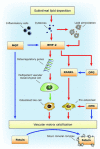Arterial calcifications
- PMID: 20716128
- PMCID: PMC3822559
- DOI: 10.1111/j.1582-4934.2010.01139.x
Arterial calcifications
Abstract
Arterial calcifications as found with various imaging techniques, like plain X-ray, computed tomography or ultrasound are associated with increased cardiovascular risk. The prevalence of arterial calcification increases with age and is stimulated by several common cardiovascular risk factors. In this review, the clinical importance of arterial calcification and the currently known proteins involved are discussed. Arterial calcification is the result of a complex interplay between stimulating (bone morphogenetic protein type 2 [BMP-2], RANKL) and inhibitory (matrix Gla protein, BMP-7, osteoprotegerin, fetuin-A, osteopontin) proteins. Vascular calcification is especially prevalent and related to adverse outcome in patients with renal insufficiency and diabetes mellitus. We address the special circumstances and mechanisms in these patient groups. Treatment and prevention of arterial calcification is possible by the use of specific drugs. However, it remains to be proven that reduction of vascular calcification in itself leads to a reduced cardiovascular risk.
© 2010 The Authors Journal compilation © 2010 Foundation for Cellular and Molecular Medicine/Blackwell Publishing Ltd.
Figures
References
-
- Kopp AF, Ohnesorge B, Becker C, et al. Reproducibility and accuracy of coronary calcium measurements with multi-detector row vs electron-beam CT. Radiology. 2002;225:113–9. - PubMed
-
- Iribarren C, Sidney S, Sternfeld B, et al. Calcification of the aortic arch: risk factors and association with coronary heart disease, stroke, and peripheral vascular disease. JAMA. 2000;283:2810–5. - PubMed
-
- Taylor AJ, Bindeman J, Feuerstein I, et al. Coronary calcium independently predicts incident premature coronary heart disease over measured cardiovascular risk factors: mean three-year outcomes in the Prospective Army Coronary Calcium (PACC) project. J Am Coll Cardiol. 2005;46:807–14. - PubMed
-
- Arad Y, Goodman KJ, Roth M, et al. Coronary calcification, coronary disease risk factors, C-reactive protein, and atherosclerotic cardiovascular disease events: the St. Francis Heart Study. J Am Coll Cardiol. 2005;46:158–65. - PubMed
Publication types
MeSH terms
LinkOut - more resources
Full Text Sources
Research Materials


